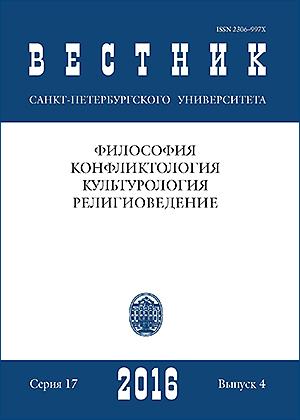ЯЩИК ПАНДОРЫ: РЕЛИГИЯ, ЭКОЛОГИЯ И ПОПУЛЯРНАЯ КУЛЬТУРА
DOI:
https://doi.org/10.21638/11701/spbu17.2016.410Аннотация
Статья посвящена связи между экологией религии и популярной культурой. В последнее время эти направления актуальны как для современного культурологического дискурса, так и для религиоведческих исследований, а энвайронментализм часто рассматривается как фор- ма имплицитной религии. Картина Дж. Кэмерона «Аватар», будучи показательным продуктом популярной культуры, поднимающим вопросы защиты окружающей среды, находится в цен- тре данного исследования. Культура и религия Нави, созданная в фильме, интерпретируются в тесной связи с природой Пандоры. Методологический подход, подчеркивающий важность изучения архаических религий в их сосуществовании с природой, был разработан О. Хульт- кранцом, теория которого легла в основу экологии религии, но в данной статье она применя- ется для исследования продукта популярной культуры. В «Аватаре» можно увидеть целый ряд религиозных представлений, начиная с индуистского термина, использованного для заглавия фильма, и заканчивая своеобразным анимизмом и пантеизмом. Эти религиозные идеи вызва- ли резкую критику со стороны некоторых католиков и протестантов, обвиняющих картину в пропаганде поклонения природе, которая превращенна в богиню, а экология — в религию. Вместе с тем само христианство часто критикуется за пренебрежение природой, вытекающее из борьбы с язычеством. Так «Аватар», продвигающий совершенно иное отношение к природе, в некотором смысле возвращает нас в дохристианскую эпоху. Религиозные воззрения Нави можно рассматривать в качестве “dark green religion”, а главного героя — как радикального энвайронменталиста. Образ благородного дикаря определенно романтизируется в картине, но трудно отрицать, что в сфере религии, экологии и популярной культуры работа Кэмерона стала ключевой вехой. Пандора, изобретенная им, открыла свой ящик, чтобы заставить нас задуматься о связи религии и экологии посредством доступного языка популярной культуры. Библиогр. 24 назв.
Ключевые слова:
экология религии, популярная культура, энвайронментализм, «Аватар»
Скачивания
Библиографические ссылки
Загрузки
Опубликован
Как цитировать
Выпуск
Раздел
Лицензия
Статьи журнала «Вестник Санкт-Петербургского университета. Философия и конфликтология» находятся в открытом доступе и распространяются в соответствии с условиями Лицензионного Договора с Санкт-Петербургским государственным университетом, который бесплатно предоставляет авторам неограниченное распространение и самостоятельное архивирование.






